
Battle of the Cabrera Strait, 1806
13th October 2024, 2 Comments
The Age of Fighting Sail, Kiss me Hardy!, 1/1200 scale
The idea was to stage a small naval game, to entice my friend Jim into naval games. The game was set in 1806, and involved a small Spanish squadron which had been blockaded in Palma on Mallorca for months. A gale though, forced the blockading British squadron to run for shelter, and the Spanish Admiral Juan de Mondragón seized his chance to make a run for Cartagena,where the rest of the fleet were waiting. 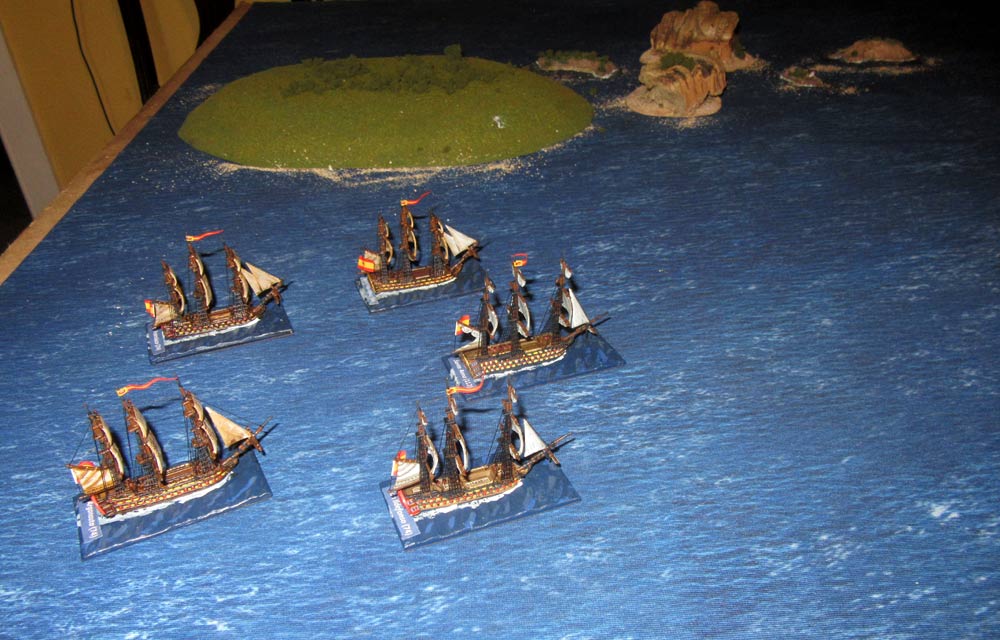 However, on passing the rocky islands of Cabrera and the smaller Illa des Conills, the Spanish spotted a small group of British ships of the line lying across their path. Rather than return to Palmas and lose face, Mondragón decided to fight. After all, he had the edge in ships, guns and men – everything but quality. Coolly, Rear Admiral James Saumarez formed his four ships into line of battle, and waited for the enemy to come within range.
However, on passing the rocky islands of Cabrera and the smaller Illa des Conills, the Spanish spotted a small group of British ships of the line lying across their path. Rather than return to Palmas and lose face, Mondragón decided to fight. After all, he had the edge in ships, guns and men – everything but quality. Coolly, Rear Admiral James Saumarez formed his four ships into line of battle, and waited for the enemy to come within range. 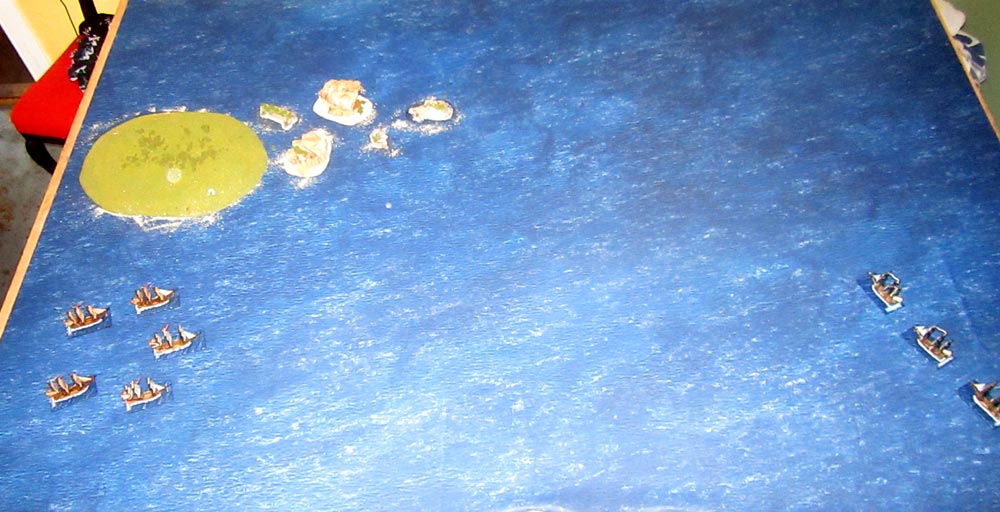 The Spanish squadron, led by Mondragón in the Santa Anna (112 guns) tried to form his squadron into a matching battle line, without complete success. His flagship was the first in range, and the Santa Anna opened fire, followed a turn later by the next astern, the San Augustin (74), then the San Ildefonso (74). For their part the British held their fire. Soon the Argonauta (74) joined ion, but for the moment the San Francisco (74) didn’t have a clear line of fire.
The Spanish squadron, led by Mondragón in the Santa Anna (112 guns) tried to form his squadron into a matching battle line, without complete success. His flagship was the first in range, and the Santa Anna opened fire, followed a turn later by the next astern, the San Augustin (74), then the San Ildefonso (74). For their part the British held their fire. Soon the Argonauta (74) joined ion, but for the moment the San Francisco (74) didn’t have a clear line of fire. 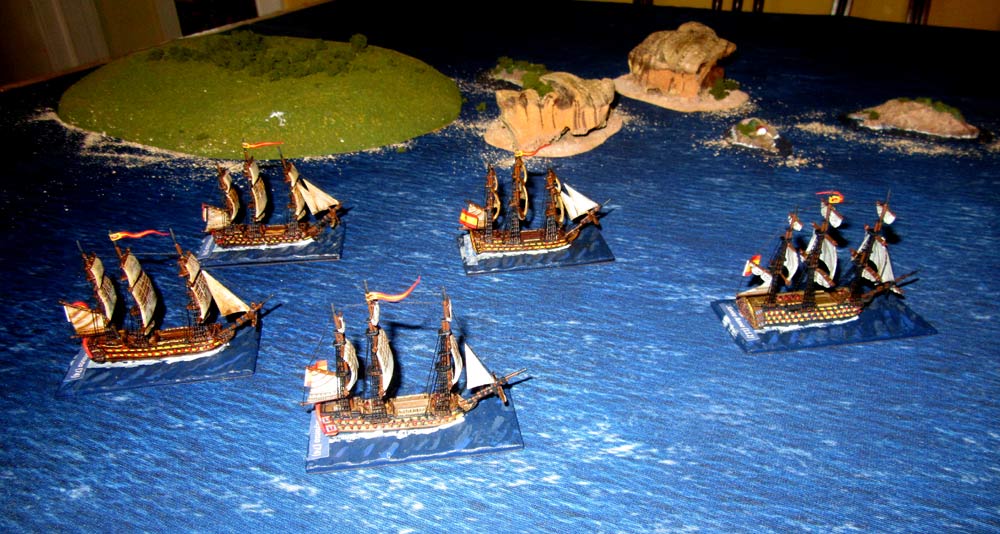 Admiral Mondragón had been trying to use the wind to get ahead of the British, and ‘cross their T’, giving him a real advantage which might counter the British edge in gunnery. This though, looked increasingly like it wouldn’t work. The strong southerly breeze favoured both sides, and it looked like the British might cross the ‘T’ of the Spanish, rather than the other way round. So, Mondragón decided to round the islands, then head back to Palma.
Admiral Mondragón had been trying to use the wind to get ahead of the British, and ‘cross their T’, giving him a real advantage which might counter the British edge in gunnery. This though, looked increasingly like it wouldn’t work. The strong southerly breeze favoured both sides, and it looked like the British might cross the ‘T’ of the Spanish, rather than the other way round. So, Mondragón decided to round the islands, then head back to Palma. 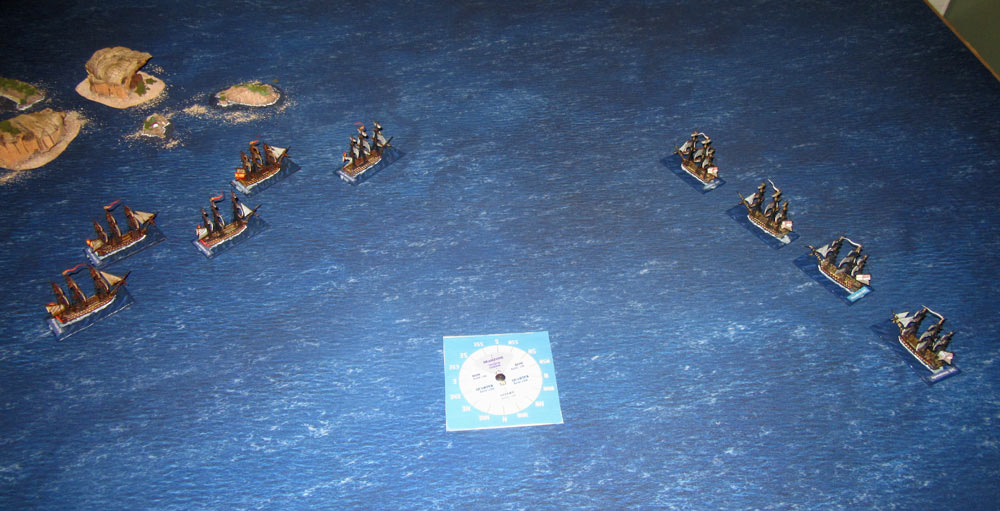 When the range dropped to short range the British opened fire. Saumarez wasn’t in the lead – Thunderer (74) was, as the British had formed line just after racing to intercept the enemy. Behind her was Agamemnon (64), followed by Saumarez in Bellerophon, with Mars (74) bringing up the rear. This initial close-range broadside proved devastatingly effective, as Thunderer and Agamemnon concentrated their fire on the Santa Anna, which was hit hard.
When the range dropped to short range the British opened fire. Saumarez wasn’t in the lead – Thunderer (74) was, as the British had formed line just after racing to intercept the enemy. Behind her was Agamemnon (64), followed by Saumarez in Bellerophon, with Mars (74) bringing up the rear. This initial close-range broadside proved devastatingly effective, as Thunderer and Agamemnon concentrated their fire on the Santa Anna, which was hit hard.  Things were starting to look bad for the Spanish, but somehow they managed to form a proper firing line, and were soon firing everything they had at the British. the trouble was, it wasn’t really enough. the British were simply much better at gunnery (rated ‘jack tars’ rather than ‘lubbers’), and so they had the worst of the exchange. the two British ships kept concentrating on the Spanish flagship, which began to suffer badly – enough to warrant a ‘Strike Test’.
Things were starting to look bad for the Spanish, but somehow they managed to form a proper firing line, and were soon firing everything they had at the British. the trouble was, it wasn’t really enough. the British were simply much better at gunnery (rated ‘jack tars’ rather than ‘lubbers’), and so they had the worst of the exchange. the two British ships kept concentrating on the Spanish flagship, which began to suffer badly – enough to warrant a ‘Strike Test’. This went spectacularly badly for the Spanish, and Santa Anna hauled down her colours. With Mondragón out of the picture, the Spanish captains all opted to head back to Palmas. This though, wasn’t going to be easy, as the British now turned to port, and blocked their route home. The only two options left were to give battle, and try to fight their way through, or to turn about into the wind, and go back around the south of the islands.
This went spectacularly badly for the Spanish, and Santa Anna hauled down her colours. With Mondragón out of the picture, the Spanish captains all opted to head back to Palmas. This though, wasn’t going to be easy, as the British now turned to port, and blocked their route home. The only two options left were to give battle, and try to fight their way through, or to turn about into the wind, and go back around the south of the islands. 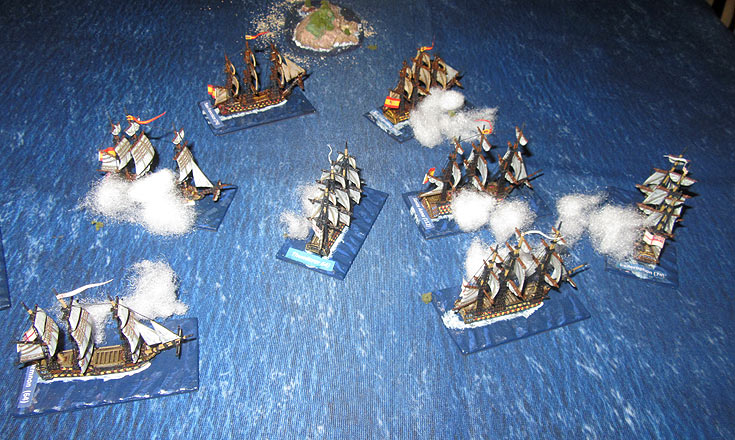 The Spanish had also lost their edge in numbers – both sides now had four ships in the fight – and the British were better at shooting. This meant that the Spanish now had a real problem extricating themselves from what increasingly looked like a trap. What followed was something of a point-blank melee, fought off the north-eastern tip of the rocks and shallows of the Illa des Conills. Actually, it was more like a free-for-all dogfight!
The Spanish had also lost their edge in numbers – both sides now had four ships in the fight – and the British were better at shooting. This meant that the Spanish now had a real problem extricating themselves from what increasingly looked like a trap. What followed was something of a point-blank melee, fought off the north-eastern tip of the rocks and shallows of the Illa des Conills. Actually, it was more like a free-for-all dogfight! 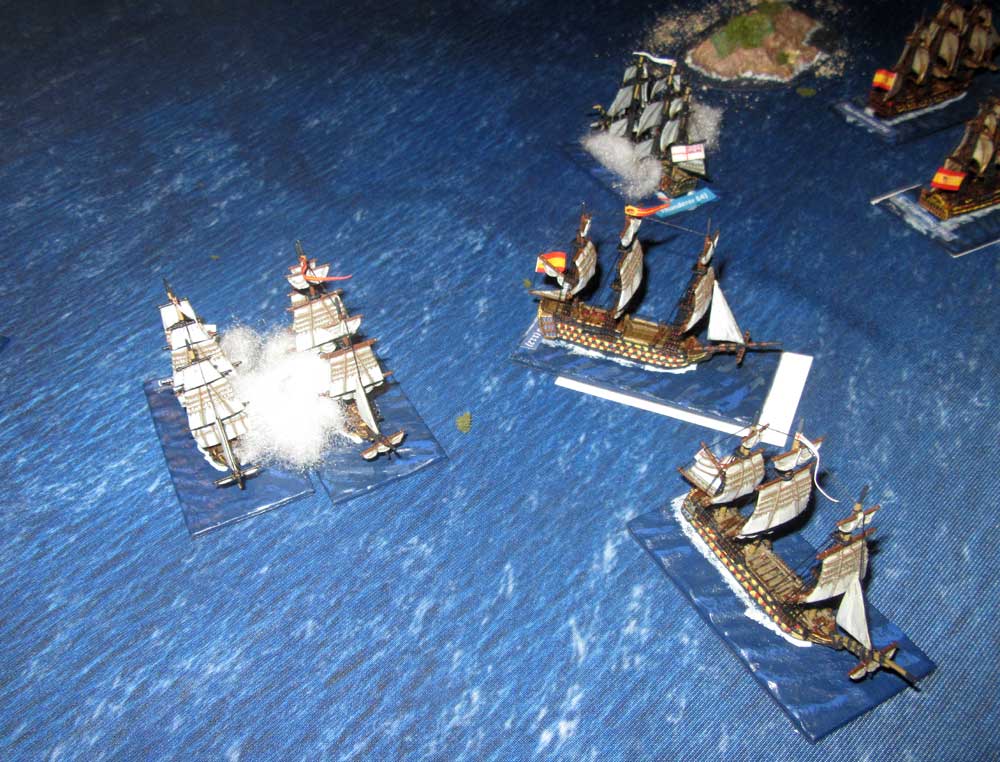 This though, could only really go one way. The San Ildefonso and the San Augustin managed to round the islands, but the Argonauta found herself blocked by Bellerophon, which lined up yardarm to yardarm and pounded the Spanish ship-of-the-line into submission. The Argonauta struck her colours, while Thunderer and Agamemnon chased the two Spaniards rounding the island. San Francisco tacked neatly, and headed away to the south-west.
This though, could only really go one way. The San Ildefonso and the San Augustin managed to round the islands, but the Argonauta found herself blocked by Bellerophon, which lined up yardarm to yardarm and pounded the Spanish ship-of-the-line into submission. The Argonauta struck her colours, while Thunderer and Agamemnon chased the two Spaniards rounding the island. San Francisco tacked neatly, and headed away to the south-west. 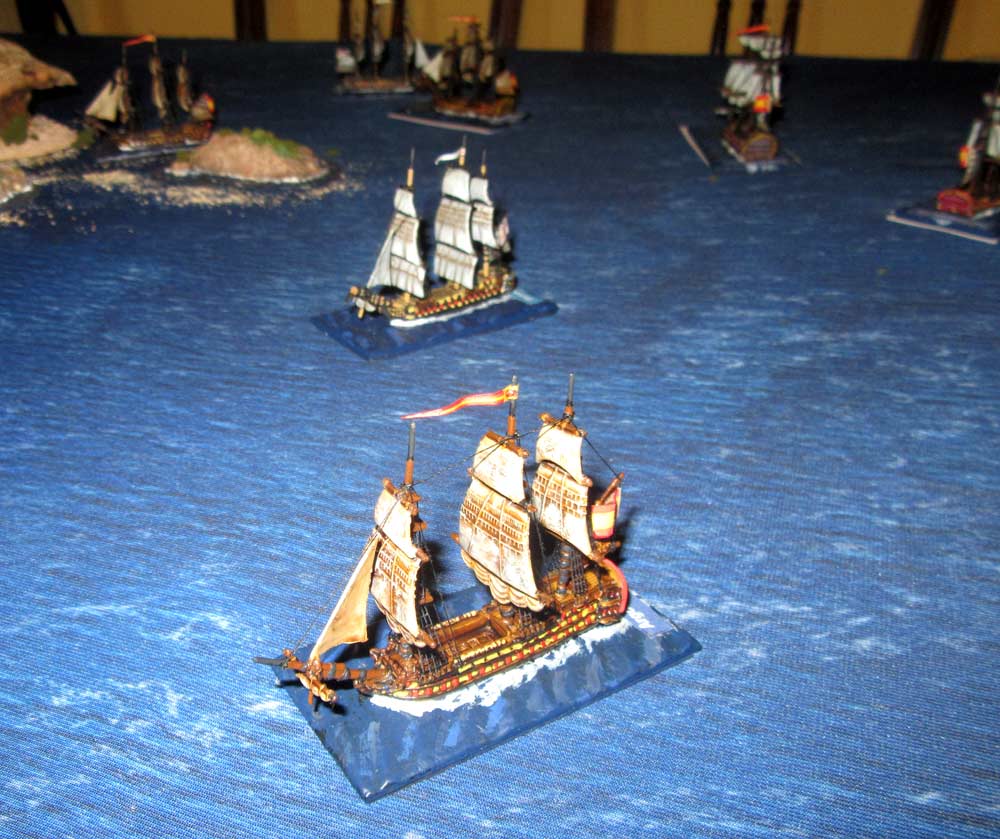 Mars, the rearmost British ship gave chase, but the Spanish ship-of-the-line was better placed, and although both had the wind just off their bow, the San Francisco was further from the shore, and was able to raise her full sails, to speed her on her way. this was boosted by a slight change of wind to the SSE, and she began to pull away to safety. On the other side of the island though, the San Ildefonso wasn’t so lucky.
Mars, the rearmost British ship gave chase, but the Spanish ship-of-the-line was better placed, and although both had the wind just off their bow, the San Francisco was further from the shore, and was able to raise her full sails, to speed her on her way. this was boosted by a slight change of wind to the SSE, and she began to pull away to safety. On the other side of the island though, the San Ildefonso wasn’t so lucky. 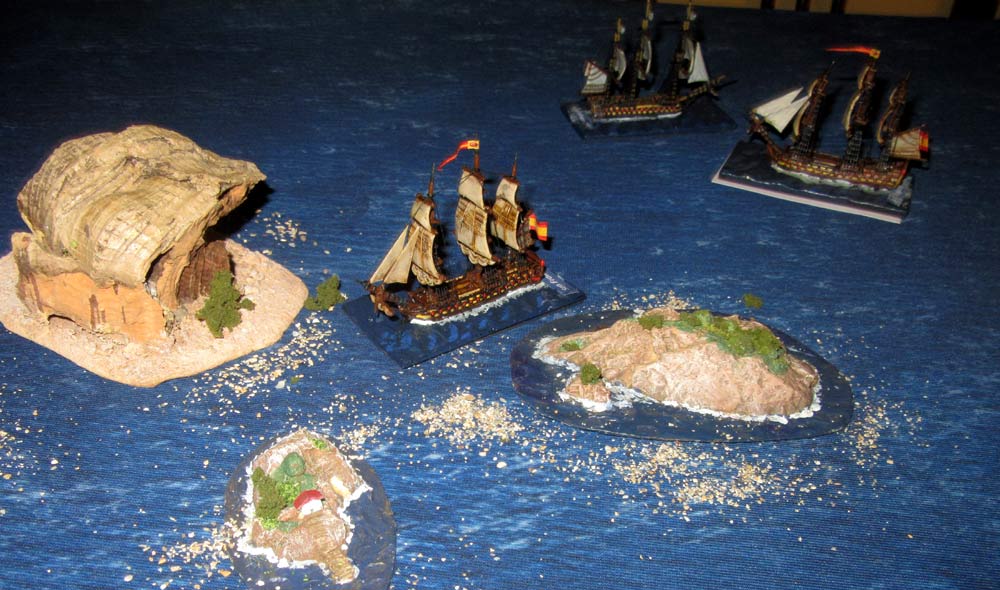 The Spanish 74-gunner was close inshore, and when a lucky hit from the Agamemnon struck her wheel, and the San Ildefonso veered to port, straight onto the rocks. The San Francisco was able to put on sail and escape though, and this effectively brought this brisk little action to an end. The Spanish had lost three ships-of-the-line, and the British none, but the fun we had playing it all out was far more important than the final lop-sided scoreline!
The Spanish 74-gunner was close inshore, and when a lucky hit from the Agamemnon struck her wheel, and the San Ildefonso veered to port, straight onto the rocks. The San Francisco was able to put on sail and escape though, and this effectively brought this brisk little action to an end. The Spanish had lost three ships-of-the-line, and the British none, but the fun we had playing it all out was far more important than the final lop-sided scoreline!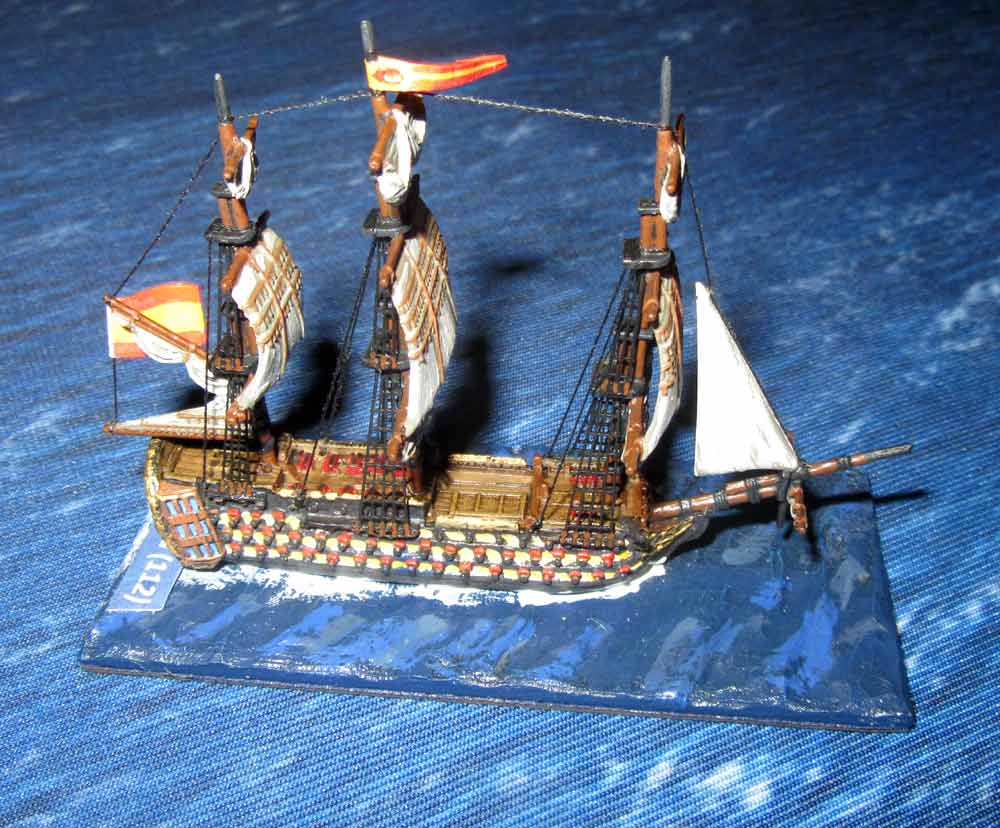


I love your islands and ships. We will game this period next weekend. Thank you for your impressions!
Thank YOU Sir, for your kind comments! I wish you luck in your game!